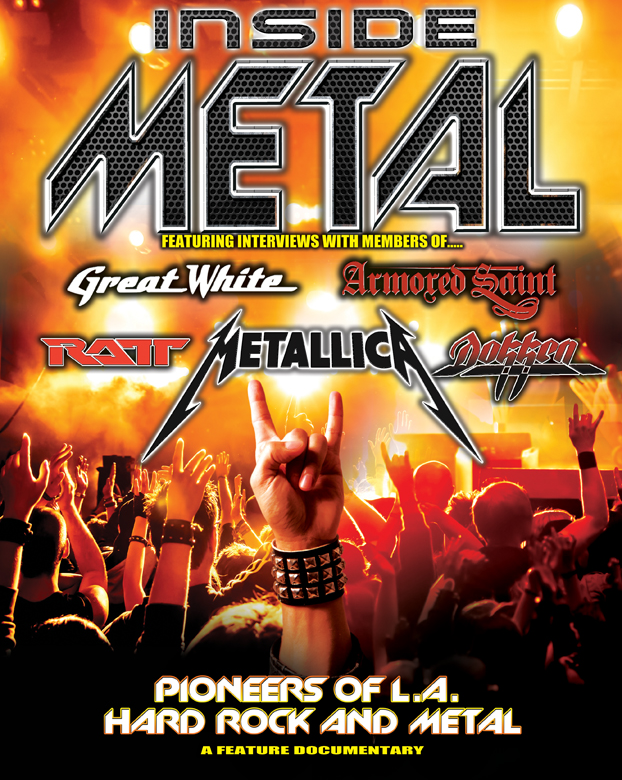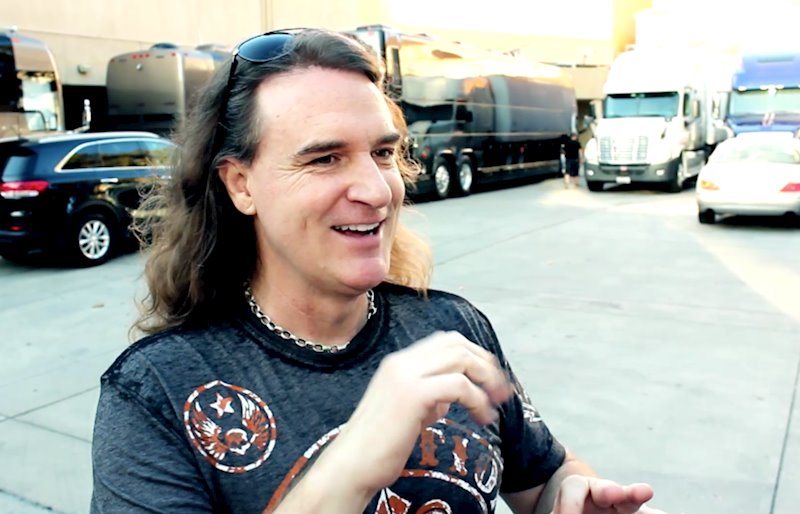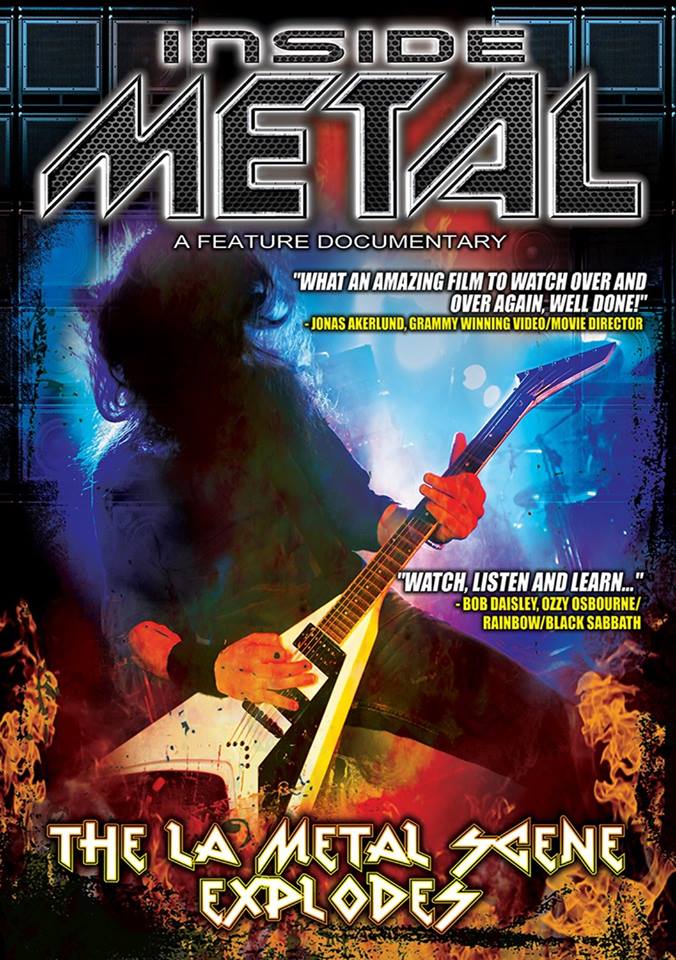Inside Metal has become a series of documentaries. Releasing two prior films. Pioneers of LA Hard Rock 1 & 2 and Metal and LA Metal Scene Explodes 1 & 2, for anyone that is unaware of these, tell us a little bit about these films?
Bob Nalbandian: Yeah. When I got approached from Warren Croyle, Executive Producer, and Joe Floyd, the idea was to do a documentary on the L.A. scene and kind of cover from the beginning of the L.A. hard rock and metal scene. We were all avid metalheads. Joe Floyd was in the band Warrior, I sport their t-shirt now, and they had a production company and everything they were doing. So, it was a great idea. I had known Joe for years. He got me on board to direct and he was producing and filming everything. And we just started doing interviews. And then after we did all of the interviews we are like “There’s no way this is all going to fit in one movie. So, we decided to split it up into three different movies that each movie was so long it had to be two parts. Each film, there’s a part one and a part two. That’s how that happened.
 And we split it up because the first movie “Pioneers of L.A. Hard Rock and Metal” is the beginning of the hard rock scene in L.A., the Van Halen era, The Starwood, all those clubs. Bands like Legs Diamond, when Angel first came over to L.A. And Yesterday and Today coming up down from the Bay Area, they did several shows in L.A. And, of course, Legs Diamond and bands like Snow, Alucard and Quiet Riot with Randy Rhoads. We covered that real early era that never gets talked about it. That was a lot of fun. And it goes into the beginnings of bands like Mötley Crüe, and young Dante Fox who turned into Great White, and Don Dokken, he was in a band called Airborn. George Lynch was in a band called Xciter. Tommy Lee was jamming with Greg Leon and Joey Vera from Armored Saint. And Nikki Sixx had a band called London. All these guys were around from way back then and we kind of wanted to cover that early scene of that. That’s what The Pioneers is. It goes from 75 to 81.
And we split it up because the first movie “Pioneers of L.A. Hard Rock and Metal” is the beginning of the hard rock scene in L.A., the Van Halen era, The Starwood, all those clubs. Bands like Legs Diamond, when Angel first came over to L.A. And Yesterday and Today coming up down from the Bay Area, they did several shows in L.A. And, of course, Legs Diamond and bands like Snow, Alucard and Quiet Riot with Randy Rhoads. We covered that real early era that never gets talked about it. That was a lot of fun. And it goes into the beginnings of bands like Mötley Crüe, and young Dante Fox who turned into Great White, and Don Dokken, he was in a band called Airborn. George Lynch was in a band called Xciter. Tommy Lee was jamming with Greg Leon and Joey Vera from Armored Saint. And Nikki Sixx had a band called London. All these guys were around from way back then and we kind of wanted to cover that early scene of that. That’s what The Pioneers is. It goes from 75 to 81.
L.A. Metal Scene Explodes is like 81 to 86 and it’s really when the scene exploded when Motley Crue, Quiet Riot got their big record deal with CBS. Armored Saint, Black and Blue, Wasp, Warrior, Malice, Rough Cut, I could go on and on, all these bands were getting major label deals and the scene just exploded. MTV was happening, and it was Ratt of course. We interviewed all those guys and that’s The L.A. Metal Scene Explodes. Including all the other bands, Racer X, and Leatherwolf, and London. That’s got tons of tons of bands. And then rather than going late 80s and covering that real hair metal scene of Poison, Warrant and even going on to Guns N’ Roses and all of that, it’s like “That’s been done so many times. What can we do from that?”
We wanted to cover more of the underground era, the era that we are really into and we are like man the LA Thrash scene was always so underground. Because the glam scene was so huge in L.A. the thrash scene kind of got pushed under the table and then, of course, San Francisco got all the props for the thrash. But we were thinking Dark Angel, Highrise and, of course, Metallica started in L.A. their early club shows. So, did Megadeth, Slayer, I used to see them as a cover band in L.A. And then you had Abattoir, Agent Steel, and Suicidal Tendencies. And the crossover bands Cryptic Slaughter, and all that kind of stuff going on. None of those bands got a lot of props so we decide “Let’s make the third one on the L.A. thrash scene, and that’s how Rise of L.A. Thrash Metal came about. I know it’s a long answer but–
No, that’s okay. A lot of people don’t know about that, even though that was my time, I was more into the glam metal, hair band genre. So, this is interesting to me because I get to see that genre that I didn’t experience at that time.
Well, the interesting thing is although this is before the subgenres came about. It wasn’t even called thrash metal then, it was all like speed metal. All those bands– Metallica, we interviewed Lars, he talks about some of the early shows. We interviewed Stryper in this movie because they talk about playing with Metallica when they were Rock Regime, and they talk about playing with Raven and Anthrax. All these bands played together, the early club scene– At times I saw Metallica, they were playing with Steeler and Ratt, and all those kind of bands, August Redmoon and Dante Fox. All the bands played together, Dark Angel played with the hair bands, Slayer played with– Steven Craig their old manager talks about them playing The Troubadour with bands St. Valentine and all the glam bands. It was just all in one. There weren’t those subgenres yet.
Well, that’s what I was going to ask you because the list of artists is phenomenal, there are a few I had no idea they were considered Thrash Metal. Wolf Hoffmann and Peter Baltes of Accept, and members of Stryper even Armored Saint, that caught me by surprise.
Well, this title is called “The Rise of L.A. Thrash Metal” so it’s how the thrash metal scene really came about. And it really came about from the new wave of British heavy metal and European metal. And, of course, Accept to a lot of people credit the song Fast as a Shark to the beginning of thrash metal. That was before Metallica. As well as bands like Raven, and we got John Gallagher in this, they were like really speedy– they called themselves “athletic rock”, I remember back then. But that was like real speed metal where the genre came about. And, of course, Diamond Head, huge influence. First time I saw Metallica they played like six Diamond Head songs, they did all covers except for Hit the Lights so that goes to show you the influence of the new wave of British heavy metal. A lot of people go “oh no that’s not thrash”, it’s Stryper. They are not thrash.” it’s like “I know that, we want to tell the story of the thrash scene.”
That explains it.
Exactly. And then you got the other side of the punk scene too. Bands like Suicidal who went and crossed over to the thrash metal scene. So, it really tells the birth of how thrash metal came about.
Bob, how did you get Dave Ellefson of Megadeth to narrate this documentary?
I’ve been friends with Dave ever since the very beginning of Megadeth. I knew Dave Mustaine and Metallica, we were good friends. He was Huntington Beach, I lived in Huntington Beach and I followed all the early Metallica shows. I had a fanzine called The Headbanger. As soon as he got kicked out of Metallica and came up from New York he called me, we did a big interview with him, and him and David Ellefson. That was the first time I met David Ellefson. It was literally the week Megadeth was born. That’s how long I know him, from 1983. I think that interview was in January of 1984. So, we go way back. I narrated the first one, The Pioneers of L.A. Hard Rock and Metal, I wasn’t happy with my voice on it. I figured “It’ll be great if I get someone in the bands to narrate.” So, the second one, John Bush did, The L.A. Metal Scene Explodes, he’s got a great voice. He does voiceovers. He does the Burger King commercials and stuff like that.
I did not know that.
Yeah. And same with Dave Ellefson, he’s got such a great speaking voice, he’s very professional, he knows the scene inside and out, so he was the obvious choice for narrates.

I asked Dave Ellefson this question too. Metallica, Megadeth, and Slayer are three of the Big 4, that is from Los Angeles. With Slayer announcing they are retiring, how does that affect the scene? They are a staple in the Thrash Metal fabric.
Sure. Well, thrash metal is always going to survive. And I know Kerry King is going to continue. When you get in your 50s and stuff, especially playing thrash metal, a lot of people don’t see thrash metal it takes its toll on your body. Tom Araya has had a neck and back surgery, so is Dave Mustaine, so is James Hetfield. All these guys when you are thrashing about like that it’s going to really take a toll on your body. And I know it’s been rough for Tom Araya to tour. I think it’s more for physical reasons. And you want to keep your integrity too. You don’t want to go out there as an old man just playing “Angel of Death” with a cane. It just doesn’t look right. It could maybe work for more classic bands like Deep Purple and stuff but when it comes to thrash metal. And I am sure, of course, Gary Holt, he’s got Exodus, and he’ll continue with theirs. And they always use that thing about retiring and then they kind of say “We are not going to tour anymore.” so I wouldn’t be surprised if Slayer does some one-off shows at some big festivals over the next three or four years, maybe one or two shows. Or like a “Big Four Festival” again. Don’t rule that out.
When I was doing my research, I understand you are editing a San Francisco documentary featuring all the Bay area bands, when is this expected to be released and what part of that are you covering in this documentary?
Well, we did the L.A. scene and we knew– in fact, I already got a couple of questions earlier “Well, what about San Francisco? They are the thrash…” Alright so, we got to be fair and include the San Francisco scene. I got a good friend, John Stravinsky, who grew up in San Francisco, he had a magazine called Metal Randevu, he covered that. And we got Ron Fantano involved, he did metal mania up there and they were the key guys from San Francisco, so they are deeply involved. And then we got, a lot of the L.A. fans, we got a whole section in this Rise of L.A. Thrash Metal about the L.A. bands going up to San Francisco. And then the San Francisco scene we have them as well talking about their first time in San Francisco, how we differ because we are so close. That was where Megadeth did their first shows in San Francisco with Kerry King. San Francisco was a huge part of it, so we had to include them. And that’s going to come out probably in August. And that’s going to be all metal, we said “Well, let’s talk about some of the–” just like I always said, In L.A. the thrash metal scene was kind of pushed under the table. I think San Francisco the more mainstream metal scene whether that be the glam bands like Jet, Warrior, or Vain, or earlier bands like Head On, Roadrunner, and mainstream just metal, power metal like Lost Rocket, Heathen, we want to include all those too. It’s got a big array of different genres in that one.
Is there anything specific that you would like the viewers to take from your documentaries?
Well, it’s really an educational thing. I want to really take the viewer back into that time where it was so pure, and it was just like– Nobody had any expectations, especially the thrash bands. No one knew how big it was going to be. All they wanted to be was as big as– Motorhead were the kings, “If we could be as big as Motorhead and have that respect to be in the loudest, fastest, envious” … that was the only thing on their mind. No one thought they were going to have gold, platinum or triple platinum records, or in the case of Metallica being the biggest rock band in the world. That was unheard of. It was such a pure scene. I think that’s what we really try to capture with this, the purity of that scene. I love educational documentaries whether be on metal, whether be on rock, whether be of any kind — not even music oriented. I think it’s a great learning tool and I hope people get that out of this.
How did it start with interviewing the musicians? Was it by word of mouth? Did you just have a core that you wanted to talk to? Because there are quite a few artists?
It just kept rolling. Once I started with Joe Floyd and then we got a partner, Co-Producer Karl Alvarez became a big part of it so, collectively we just called all the– Like I said, I wrote for a lot of fanzines and magazines throughout the 80s. I knew all these guys personally so I didn’t have to go through a lot of management companies or the record labels, I just “Hey, I am doing this, talk to us.” It just started rolling and being based in L.A. at the time and Joe’s got a recording studio out there. Most of them would come to the studio and one after the next and then someone said “Oh, we should get– I am friends with so and so. Oh, we need to get him.” and so he got on the phone “Come down, Bob is doing a documentary.” It just started rolling and so we had too many interviews. Warren, our Executive Producer, is like “Dude, start editing this damn thing. I got way too many interviews because we can’t fit them all into one. But better too much than not enough, right?
That’s true!
Is there anything else you would like to add?
No, just, you know, part one is out, you can get through Amazon and a lot of the streaming outlets, DVD, as well as it’s going to go on pay-per-view. Part two of the movie will be out April 3rd, so you want to get both to get the whole story of the scene because it’s a two-part scene. So that’ll be coming out April 3rd through the same outlets. And, yeah, you can go to metalrockfilms.com and Amazon is always a great place to order the DVD or Amazon Prime you can stream it. So, check it out.
Thank you very much, I’m excited to see both parts of this documentary.
SHARE THIS POST:


